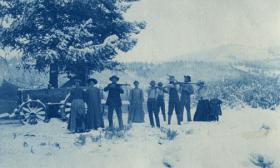Sir St. George Gore was born in 1811 in County Donegal, Ireland, heir to an Irish baronetcy and was often referred to as Lord Gore. He was educated as an aristocrat, never married, and never held public office.
He staged an expensive and expansive “American hunt,” leaving Westport, Missouri on June 6, 1854, with plans to hunt in the southern Rockies. After spending some time at Fort Laramie, he arrived inMiddle Park. His guides were Joseph Chattillon and Jim Bridger. Gore had a entourage of 40 workers, 25 wagons, 24 mules, 112 horses , 3 milk cows and 14 dogs!
Loving his luxury, he slept in a brass bed, had nightly hot baths, and dines on superb food served on a lace tablecloth set with fine silver and crystal. He often invited Bridger, who was illiterate, to dinner and awakened in the guide an interest in Shakespeare, which lead to the frontiersman hiring a boy to read the bard's plays to him.
Described as "a good shot at rest but rather poor offhand" he nevertheless claimed to have killed 2,500 buffalos, 40 grizzly bears and countless deer, elk and antelope.
Bridger led Gore to West Grand County, to the pass, range, and canyon that now bear his name. The Indians were shocked at the expedition's wanton slaughter of every game animal in sight.
The expedition did not end until sometime in 1857, when Gore returned to Ireland and relative obscurity. Not even a portrait remains of the infamous poacher.
R.C. Black, Island in the Rockies, Pruett Press, 1969
Abbott Fay, To Think That This Happened in Grand County!, Grand County Historical Association, 1999
Stanley Vestal, Jim Bridger, Mountain Man: A Biography, New York: Morrow, 1946









